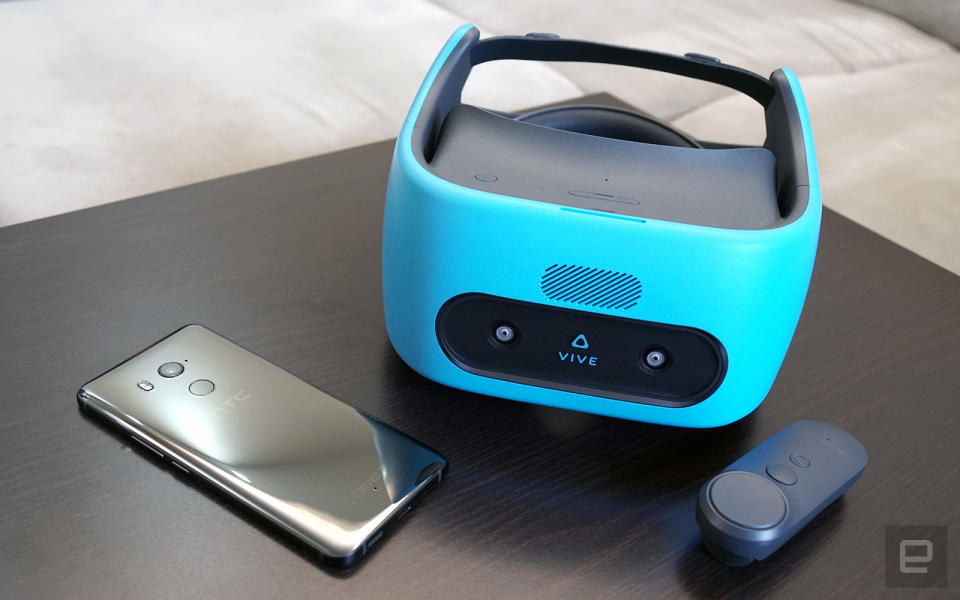Vive Focus VR update lets you take calls from the real world
HTC's standalone VR headset is about to get a whole lot more useful.
Even though the Vive Focus won't be available outside of China until later this year, it's already getting a major update which will make it a lot more versatile. At the annual Vive Ecosystem Conference in Shenzhen just now, HTC announced that as of today, its standalone 6DoF (6 degrees of freedom) VR headset can install a "System Update 2.0" which adds a handful of notable features.
One of the main highlights here is the added ability to receive calls, social notifications and messages from a paired HTC smartphone, with the recently unveiled U12+ being the first model to take advantage of this immersive feature. This is nothing new for existing Vive users, of course, as the Vive companion mobile app already supports the PC-powered headset on this end.
Another cool feature brought by this major update is a "Surroundings Mode," which is basically a see-through mode that can be toggled by simply double-clicking the power button. This is likely the same mode that allowed HTC Vive's China Regional President Alvin Wang Graylin to do a catwalk while wearing a Vive Focus at the Shanghai Fashion Week back in March. During today's conference, Graylin also demoed a live phone call through the headset while walking up to the stage simultaneously -- he didn't trip.
Walked the entire runway at #GQ show with a #ViveFocus on at the #ShanghaiFashionWeek today! Coat was designed with a #VivePro by #Pronouce! #VRandFashion @htcvive pic.twitter.com/l1ULhtcMt7
— Alvin Wang Graylin (@AGraylin) March 28, 2018
One problem I had with the Vive Focus while traveling was how I could see myself drifting away in the virtual world as the vehicle -- be it a plane, a bus or a train -- changed speed or direction, and at the time, HTC told me that it was already working on a solution. This ended up being the new "Passenger Mode" that comes with the 2.0 update. Once toggled, the headset essentially switches off some of the trackers to avoid said issue, while still letting you enjoy a seated VR experience with 3DoF -- as you do with Oculus Go and Google Daydream shells. Better yet, you also gain an extra hour of battery life on top of the original three this way, but there's obviously no stopping you from keeping the headset plugged into a power bank while on the move.
The most ambitious new feature of all here is perhaps the ability to stream Steam or Viveport VR content from a PC to a Vive Focus over 5GHz WiFi. This is enabled by a third-party software called Riftcat VRidge which, until now, specializes in emulating SteamVR headsets on smartphones. All of a sudden, the Vive Focus has access to a vast library of content, though its performance and stability remains to be seen.
Last but not least, this update lets you install VR apps onto the Vive Focus' microSD card, meaning you're no longer limited by the headset's internal storage as you download more software.
But HTC isn't quite done yet. The company also teased several upcoming features that are due in Q3 this year, and these include basic hand gesture tracking via the front cameras, smartphone mirroring to headset, enhanced headset mirroring to TV, and letting the 3DoF controller behave like a 6DoF device with the help of computer vision.

HTC's very own Vive Studios even explored the feasibility of using the U12+ as a 6DoF VR controller -- be it a strumming device for a virtual guitar, or a virtual camera as you tour around a cartoonish forest. It's certainly a fun way of leveraging what little is left in HTC's mobile business.
Alas, out of all these upcoming features, I only got to try the basic hand gesture tracking, which turned out to be more "basic" than I expected -- it wasn't exactly live hand tracking, but rather, a 2D cartoon representation of my hands with just a set of five static gestures. According to Graylin, this is more of an engineering demo to show developers the potential of this API -- it only feeds the hands' 3D positions, which is sufficient for basic gesture controls like selecting items or turning a page; the developers will then get to decide what your hands look like.
The remaining features were only shown in a video preview, but if they work as advertised, then potential buyers in the West have a lot to look forward to, especially when compared to the device's direct competitor, the Google Daydream-powered Lenovo Mirage Solo.

 Yahoo Finance
Yahoo Finance 


